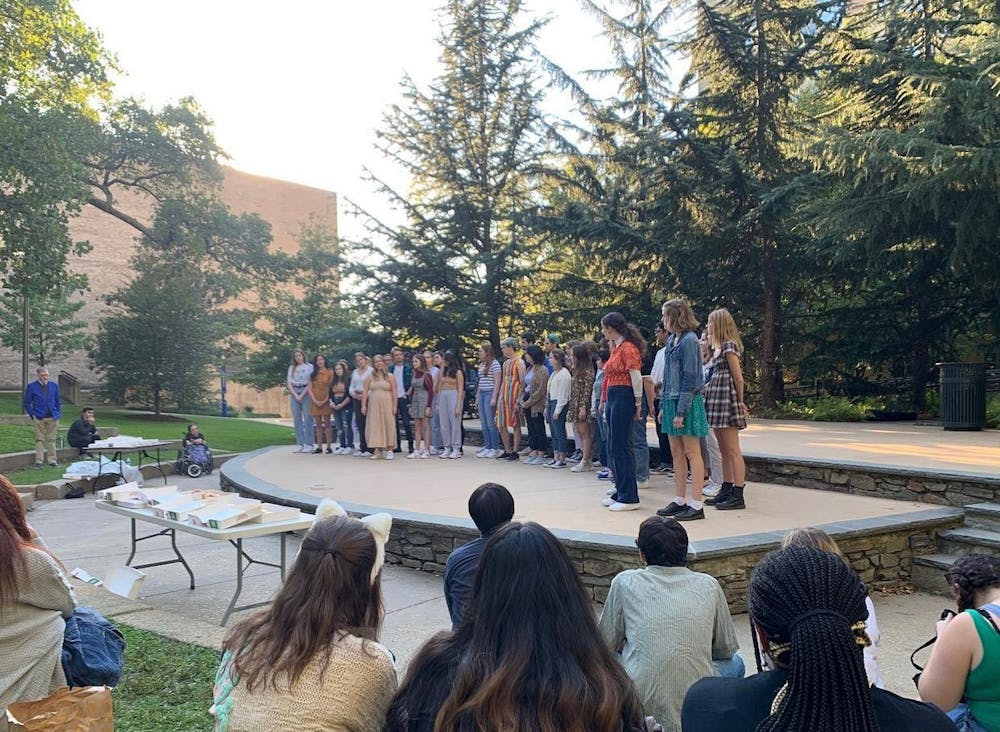Freshmen had the opportunity to showcase their work that has been invented, developed and perfected over several weeks on Oct. 9. The trigger warning on the ticketing website for “All the Hope: Overture” begs the question: how can themes of depression, anxiety and bigotry amalgamate to represent the motif of hope?
The show was completely student written and performed, split into two different shows in each half of the production with two different plots but the shared theme of hope. The actors demonstrated their creativity and hard work, despite being given little to work with in terms of sets and props. The excitement as the actors entered the dark stage was palpable as they were finally able to display their hard work after what had been months for many of not being able to perform in person. The show consisted of various short scenes and monologues compiled by the actors into a non-narrative production. It used songs from other theatrical productions to direct a show that does not follow a singular story. The scenes are generally independent of each other, but they all help to develop the message of the show. Ultimately, the show revealed that hope is inspired by those that encourage us. It dove into the many sources of hope, particularly how we as individuals rely on one another for support and optimism.
The first red show pulled music from a variety of shows. Their opening piece was “Hope” by Jason Robert Brown. The group followed the message of this song, the state of fighting to maintain hope despite internal and external struggles that may inhibit it. The show incorporated romance, heartbreak, family and mental health issues to demonstrate how every individual encounters various conflicts as they navigate through life. While those struggles are different for everyone, the concept is relatable for everyone. As the cast sang “Come Out of the Dumpster” from “The Wedding Singer,” they tried to coax one another into disregarding the tragedies of the past and step into the brightness of the prospective future. The cast choreographed beautifully intimate dances, especially during “No One Else,” from “Natasha, Pierre & The Great Comet of 1812,” which is about love and its connection to hope. The song demonstrated how love, particularly romantic relationships, can inspire us and become the forefront of our lives. “Is This Not Love” from “Twelfth Night” also follows this narrative, examining the confusion that one faces in the process of falling in love. The number was performed incredibly well, as performers take opposite sides of the stage and harmonized while the rest of the cast performs a choreographed piece. Their last song was “Move On,” from “Sunday in the Park with George.” This song tied the show together beautifully, encouraging the idea that in many cases, the only thing to do is to move onward.
The second red show exhibited similar themes of hope and its many sources for different individuals. The cast opened with a beautiful synchronized song using vocalization and body sounds, relying on each performer to come together to create this piece. Throughout the show, the actors removed and put on layers of jackets and hats, symbolizing the actors’ processes of revealing their inner character and their interpretations of hope. They performed “At the Ballet” from “A Chorus Line,” a song about finding light in certain aspects of life despite traumatic circumstances. They continued with “Perfect for You” from “Next to Normal,” a piece that acknowledges how one must accept the thing they cannot change to have an optimistic perspective. Overall, the show did a spectacular job in representing how individuals must rely on one another by nature to maintain hope and positivity.
According to performer and freshman Charles Sinche, the show does not only signify hope: “To me it means community.”
Sinche, a musical theater major, said that the creation of the show — written and produced by the freshman musical theater class — particularly stood out because of how different it was from the majority of productions they have participated in in the past.
“[Normally] you’re given a script,” Sinche said. “You aren’t given much coaching on how to be yourself and how to connect with yourself; this show was more exploratory.”
It’s clear how the production’s theme has extended into the lives of the performers. “Overture” compiles various songs and short scenes to demonstrate the common theme of hope and what its significance is to every individual. The show demonstrates how there are always challenges to a project such as this one, but depending on those around you and encouraging one another is the best way to maintain optimism and achieve success.





